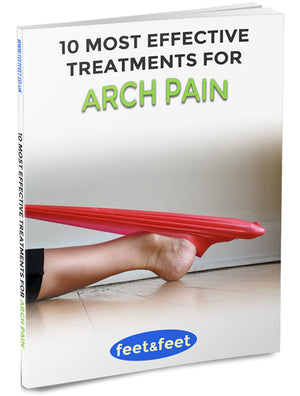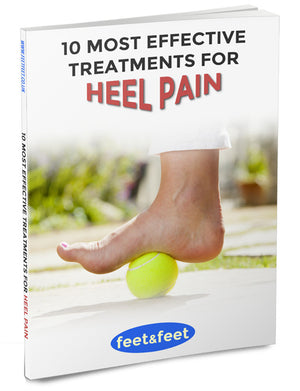10 Best Supination Exercises

Supination, also known as underpronation, can pose several problems such as hip pain, knee pain, ankle injuries and other physical issues.
It’s called underpronation because your body weight rests on the outer borders of your foot rather than the ball of your foot, causing poor distribution of pressure and weight. This leads to strains on your leg muscles and joints, thereby leading to pain and discomfort.
The following best supination exercises aims to strengthen vital muscle groups that help with relieving symptoms of supination.
1. Calf Stretches
Calf and Achilles tendon stretches helps to realign the feet and relieve any strain brought about by supination.
- Stand upright with both feet planted firmly on the floor (using a wall, table of chair for support if required).
- With your back straight, take a step back with only one leg.
- Bend your front knee, engaging your calf and along the back of your ankle to feel the stretch.
2. Tibialis Anterior Stretch
Supination can cause shin splint but stretching the tibialis anterior can help address and relieve this condition.
- Stand barefoot facing a wall.
- Put your hands on the wall and keep one foot a little further back than the other.
- Bend the front knee slightly with your foot firmly planted, stretching the hind foot slightly backwards so that your toes are bending towards the ground.
- Bend the forefoot slowly; engage your shin muscle to feel that stretch.
- Hold position for 15-20 seconds and do the same on the other foot.
3. Single Leg Stance
To perform the single leg stance exercise:
- Take a standing position and lift the unaffected foot to put your weight on the supinated foot.
- Stay in position for 15-20 seconds and then slowly bring your knee back down.
- Repeat 10 times.
4. Plantar Fascia Stretch
- To stretch your plantar fascia, start in a sitting position with your right foot planted on the floor.
- While still seated, raise one leg, placing the ankle just above the knee of the other leg.
- Grab the toes of your left foot with your hand on the same side as the raised leg.
- Slowly pull the toes back towards the front of the ankle.
- Hold for 10 seconds and repeat on the other leg; again, engage your fascia plantar to feel the stretch.
- Repeat three to five times per set on each side.
5. Heel Step Down
- While standing, place one foot before the other.
- Pause the movement once you can feel your heel on the floor.
- When your heel hits the floor, avoid rolling forward onto the ball of your foot; leave your foot suspended about one-two inches off the floor instead.
- Hold for at least 10 seconds, and then return to your starting position.
- Do 10-15 reps for each foot.
6. Jump Rope
Jump rope can help support supination by reminding and retraining your body on the proper, safe way to interact with the ground. To get the best results, ensure you jump rope barefoot on a soft or carpeted floor.
If you’re not confident with using a jump rope, then you can mimick this exercise without a rope – small and consistent jumps, using both feet to push off and land at the same time.
7. Alphabet Tracing
This exercise is great work exercising a wide range of muscles in your lower body due to the wide range of motion needed to perform it.
- Sit upright with both of your legs stretched out in front of you.
- Start tracing the letters of the alphabet one after the other using your toes. If you feel a stretch - no matter the intensity - with every letter you trace, you are doing it right.
- Trace until your muscles feel tired; the more reps you do for this exercise, the stronger your feet and ankle muscles will get.
8. Ankle Eversion
Ankle eversion is best performed with resistance band to get the best results. It targets and activates muscles that have become somewhat weakened from being excessively supinated.
- Sit on the floor; both of your legs stretched out in front of you.
- Get someone to hold the resistance band; another option is to connect it to a sturdy object or hold it with your other arm.
- Now, flex your foot and ankle back and away from the resting leg.
- Return slowly but steadily to the starting position and then do 10-15 reps per set of two to three sets.
9. Reverse Lunge
The reverse lunge exercise promotes foot and ankle stability, proper balance and strengthening of the entire leg.
- Stand up with your back straight and your feet firmly planted on the floor (keep something sturdy close by in case you need a little support).
- Leave your right foot still planted on the floor and lift your left foot off the floor.
- Hold for two seconds and then move the lifted leg back into a lunge; ensure your front knee aligns with your ankle.
- Go back to the starting position and repeat it for the other leg.
- Do two to three sets for each leg, with 10-15 reps each set.
10. Squat
- Stand about hip-width apart with your toes pointing forward (it helps to perform this in front of a mirror to ensure a better posture).
- Bend your knees, sitting your hips back toward your heels; your torso should incline forward slightly for balance.
- Hold this position for two to five seconds and return to a starting position.
- Repeat 10-15 times for two to three sets.
Conclusion
If you’re experiencing constant pain in your back, knees, hip, or leg muscles, you may be supinating while walking or running.
Research shows that supination exercises can improve dynamic stability of a supinated foot, correct balance and reduce likelihood of pain and joint problems.
A podiatrist or physical therapist can do a gait analysis to confirm and may also recommend effective exercises and other treatment options.




Leave a comment